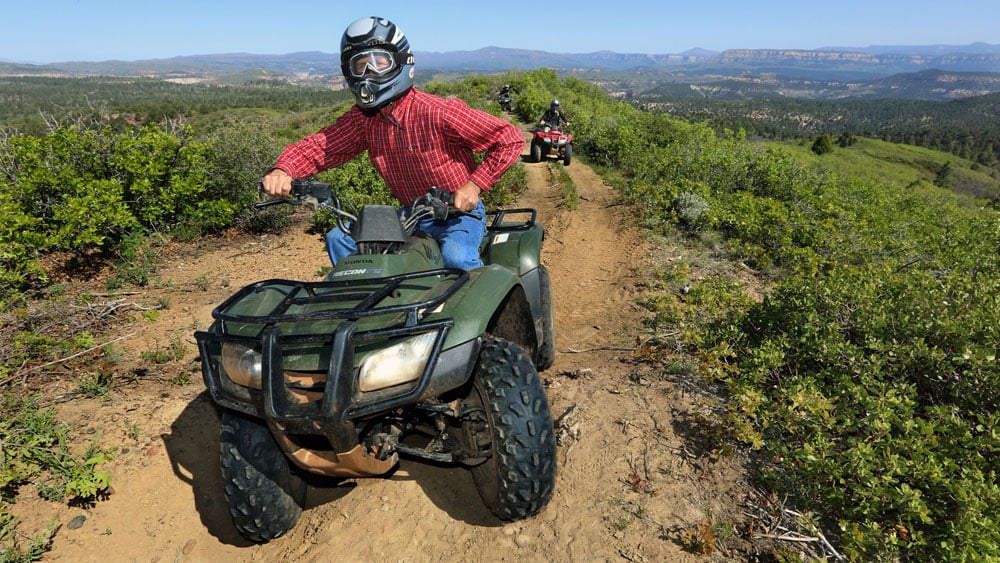ATV Riding Methods: Grasping the Art of Off-Roading

Body Positioning
To effectively navigate via tough off-road surface, it is important for ATV cyclists to regularly keep proper body positioning. Keeping the correct body position while riding an ATV not only boosts control and security however likewise ensures the motorcyclist's safety and security. By embracing the right body positioning strategies, motorcyclists can effectively disperse their weight, improve their equilibrium, and minimize the risk of mishaps or injuries.
One secret element of proper body positioning is keeping the feet on the foot fixes. Putting the feet on the foot secures enables the biker to preserve security and control over the ATV. The rider's knees must be slightly curved, offering a mild suspension to preserve and absorb shocks balance. In addition, the biker's top body ought to continue to be unwinded and adaptable, enabling for quick and smooth activities when essential. This consists of keeping a light grip on the handlebars to maintain control without excessive force.
Additionally, the motorcyclist's eyes must always be focused ahead, scanning the terrain and anticipating any kind of challenges or modifications in the path. By keeping an onward look, riders can make split-second choices and respond properly to challenging surface.
Throttle Control
Building upon the importance of proper body placing for ATV riders, grasping throttle control is a crucial ability that allows riders to efficiently steer via various off-road terrains. Throttle control describes the ability to regulate the amount of power delivered to the ATV's engine. By comprehending just how to adjust the throttle, riders can make sure a controlled and smooth acceleration, permitting them to navigate barriers with accuracy.
Among the basic aspects of throttle control is discovering to modulate the throttle smoothly. Abrupt or jerky motions can trigger the ATV to lose grip or become unstable, making it challenging to maintain control. Instead, bikers ought to go for intentional and progressive throttle inputs, specifically when traversing challenging surfaces. This strategy allows the ATV to keep a constant rate and supplies far better traction, minimizing the threat of mishaps.
In addition to smooth inflection, motorcyclists should additionally learn how to stabilize the throttle with other riding techniques, such as body positioning and braking. For example, when climbing high hillsides, cyclists require to use enough throttle to preserve momentum without subduing the ATV or creating wheel spin. When coming down steep slopes, riders should make use of the throttle in combination with correct body placing and braking to maintain control and protect against the ATV from gliding or tipping over.

Braking Strategies
A crucial aspect of ATV riding strategies is understanding efficient braking methods. Recognizing exactly how to brake correctly can make a considerable difference in your safety and control over the car when it comes to off-roading. One of one of the most important stopping strategies is using the front brake greater than the rear brake. The front brake supplies most of the quiting power, so it is vital to utilize it sensibly. However, it is very important to keep in mind that severe stopping with just the front brake can create the ATV to pitch forward, possibly bring about loss of control and even turning over. As a result, it is recommended to apply both brakes simultaneously, however with more pressure on the front brake. Another essential method is to avoid securing the wheels while braking. Securing the wheels can cause skidding, making it tough to keep control. To stop this, squeeze the brake read here levers slowly and release them slightly if you feel the wheels locking. By grasping these braking techniques, you can enhance your ATV riding abilities and make certain a safe and enjoyable off-roading experience.
Cornering Strategies
One crucial element of understanding ATV riding techniques is understanding reliable cornering strategies. Cornering on an ATV can be tough, but with the best methods, cyclists can navigate turns securely and efficiently. The secret to successful cornering is to maintain control of the ATV while optimizing grip and reducing the risk of tipping over.
To implement an appropriate cornering technique, bikers need to come close to the turn at a suitable rate, ensuring they are not going as well slow-moving or as well quick. It is critical to move the body weight towards the within of the turn, leaning into it to preserve balance and security. This assists to counterbalance the centrifugal pressure and keeps the ATV upright.
Additionally, riders should keep their eyes concentrated on the departure point of the turn rather than the instant path ahead (ATV). This permits smoother and extra accurate guiding, as it helps the motorcyclist anticipate any barriers or adjustments in terrain
Moreover, proper throttle control plays a significant duty in cornering. Bikers should regulate the throttle efficiently, preventing abrupt accelerations or slowdowns, which can trigger loss of control.
Uphill and Downhill Riding
When browsing off-road surface, ATV cyclists Check This Out should grasp the techniques for uphill and downhill riding to keep control and make certain safety and security. Downhill riding, on the other hand, needs riders to lean back and change their weight towards the rear of the ATV. By mastering the strategies for uphill and downhill riding, ATV cyclists can with confidence take on numerous off-road terrains and delight in a electrifying and safe experience.
Verdict
In conclusion, grasping the art of ATV riding calls for a mix of body positioning, throttle control, stopping strategies, and more helpful hints efficient cornering. Uphill and downhill riding likewise need specific abilities to browse safely. By implementing these techniques, bikers can enhance their off-roading experience and improve their total control and safety and security on the ATV.
ATV Riding Techniques: Mastering the Art of Off-Roading is a comprehensive overview that delves into the intricacies of mastering the abilities required for off-road ATV riding. Whether you are a beginner or an experienced motorcyclist, ATV Riding Techniques: Mastering the Art of Off-Roading provides important suggestions to assist raise your off-road ATV riding skills to the following degree.
